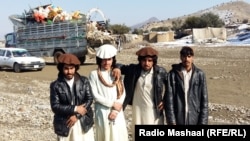Farid Khan, a Pashtun tribal leader, is eager to return to his homeland in western Pakistan’s restive Waziristan region after years of exile in neighboring southeastern Afghanistan.
The middle-aged patriarch is responsible for looking after his extended family of 22 people that includes his wife, three sons, and the families of his four brothers.
“We want nothing but to be allowed back into North Waziristan district through the Ghulam Khan border crossing,” he told RFE/RL’s Gandhara website on October 15. “We have relatives and our own lands in North Waziristan and the neighboring district of Bannu so even if we cannot be allowed back into our homes, villages, or displacement camps [in Waziristan], we will be better able to survive there.”
Maula Khan, another refugee, longs for the golden days when he enjoyed a comfortable life as a pine-nut trader in North Waziristan’s Datta Khel region, where most of the displaced in Afghanistan hail from. His extended family comprising his wife, parents, six children, and the families of three brothers shared a large mud compound surrounded by fields, orchards, and forests.
Khan says life in exile has rendered them destitute.
“We left behind everything and escaped with just the clothes on our backs,” he recalled of the hectic days in June 2014 when the Pakistani authorities ordered them to leave just hours after announcing a military operation to end nearly a decade of rule by the Taliban and allied militant groups.
“Sometimes we find it difficult to provide food for our families,” he said. “We want the authorities in Pakistan and Afghanistan to swiftly act to end our misery.” Like Farid, he feels that by allowing them back into the country, the Pakistani authorities can alleviate their suffering.
Farid and Maula’s families are among the estimated 7,000 exiled families who fled their homes in North Waziristan’s Datta Khel region with the onset of a large-scale military operation in June 2014. They were part of a much larger displacement that saw more than 1 million North Waziristan residents flee their homes with the onset of Zarb-e Azab, as the military operation was formally called. Since then, most have returned to their homes.
But still a large number of the more than 10,000 Waziristan families who fled into the adjacent southeastern Afghan provinces of Khost, Paktia, and Paktika in 2014 are waiting to be allowed back into their homeland.
Most of them live in Gulan, a rural refugee camp in the southeastern Afghan province of Khost. The mountainous region shares a border with North Waziristan, and many Pashtun tribes straddle the Durand Line border between the two countries. With declining international aid, conditions at the camp are deteriorating.
“Pakistani refugees in Afghanistan are facing a bleak future as international organizations withdraw from Gulan camp,” a report by the Norwegian Refugee Council (NRC), an international aid group, said on October 15. “Funding for their assistance is now being omitted from plans for 2020.”
The NRC warned that the funding cut will affect 7,500 refugee families, including at least 20,000 children. “They are caught in the middle of a dispute between the Afghan and Pakistani governments who lay claim over their citizenship, and as a result are unable to access their basic rights,” the organization said.
The suffering of Waziristan’s refugees reverberates in Pakistan.
“You [Pakistani authorities] told us to leave because you promised us peace. Our women and children lived in tents and braved great hardships during this displacement,” said Malik Ghulam, a tribal leader from North Waziristan’s Datta Khel region. “We now demand you should rebuild our houses and ensure peace and development similar to that in [the Pakistani capital,] Islamabad.”
Nisar Ali Khan, another tribal leader, urged Waziristan residents, particularly members of the Uthmanzai Wazir tribe, to push the authorities to declare their territories, particularly the Datta Khel region, as “cleared,” meaning safe for the return of civilians.
“We are unlikely to get anything as long as we wait for them to declare all of Waziristan as ‘cleared’ territory,” he told a jirga or tribal council in Bannu on October 15.
Authorities in North Waziristan, however, are adamant they will soon be ready to welcome some 5,000 registered Waziristan refugee families from Afghanistan.
“Some of our refugees were dispersed in many regions of [southeastern] Afghanistan, but after much difficulty, we have completed that process,” Ghaniur Rehman Wazir, a civilian official in North Waziristan, told Radio Mashaal. “We will soon launch a program for their return as soon as we complete projects for their resettlement in those areas.”
Pakistani security and civilian officials say they allow displaced residents to return to their villages after ensuring that militant and unexploded ordinances pose no threats to their safety. The government says it has built hospitals, roads, and schools and undertaken other development projects to facilitate the return of displaced civilians.
Waziristan, administratively divided into the North and South Waziristan tribal districts, turned into a bastion of Taliban and allied Islamist militants after a U.S.-led invasion toppled Afghanistan’s hard-line Taliban regime in late 2001.
Tens of thousands of civilians, militants, and soldiers were killed, and an estimated 2 million civilians were forced into displacement because of Taliban attacks and military operations that first began in 2003 and culminated with Zarb-e Azab.
Last year, the grievances of Waziristan residents and other Pashtun regions in Pakistan were united in a civil rights movement. The Pashtun Tahafuz Movement, or PTM as it is commonly known, has faced a large-scale crackdown for demanding security, rights, and accountability for what its leaders call the suffering of Pashtuns in Islamabad’s domestic war on terrorism.
Last month, a Pakistani military spokesman said some 200,000 soldiers were stationed along the country’s border with Afghanistan. Many of these soldiers are posted in Waziristan.






